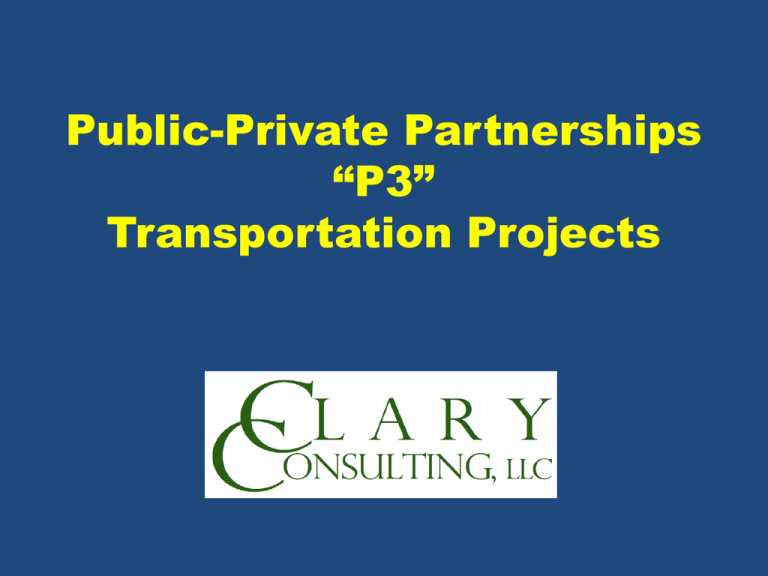P3 Presentation - Transpo 2012 10302012
advertisement

Public-Private Partnerships “P3” Transportation Projects What is a P3? • An agreement between public and private sector partners which allows more private sector participation than is traditional: – Private sector may design, construct, finance, operate, maintain, renovate and / or manage a facility or system – Public sector usually “owns” the asset and leases it to the private section – Sharing of roles, responsibilities, risks and rewards – Possibility of Private Sector equity 4/13/2015 Clary Consulting, LLC Types of P3s R • Asset Management Contract M • Design Build Finance (DBF) • Design-Build-Operate-Maintain (DBOM) M • Design-Build-Finance-Operate (DBFO) • Build-Operate-Transfer (BOT) B P M B F D F D • Build-Transfer-Operate (BTO) • Joint Development Agreement (JDA) R • Concession/Asset Lease/Sale M 4/13/2015 Clary Consulting, LLC P B F D Increasing Private Sector Role • Design-Build (DB) D B Background of P3s • “Privately” provided transportation was first and foremost in the US beginning in the 1800s lasting into the early and mid 1900s – Rail Systems – private, but regulation evolved – Development/Toll Roads – private (50k miles), then public – Public Transit Systems – private, then public – Airlines – private, but regulation evolved 4/13/2015 Clary Consulting, LLC Background of P3s (cont) • Government role grew dramatically early to mid 1900s in U.S., taking over many former private responsibilities • “Privatization” was the buzzword in the 80s and early 90s in Europe, New Zealand, etc. – Rail Systems – Aviation Systems – Highways/Toll Roads – Water/Sewer – Others 4/13/2015 Clary Consulting, LLC Past 20 plus Years “P3s” in U.S. • Outsourcing Partnerships in Government – Construction – Engineering (varies greatly by govt. entity) – Operations and Maintenance (varies) • Periodic private sector “equity” – Land donations very common – Partial or Full Cash investment – expressway interchanges 4/13/2015 Clary Consulting, LLC Characteristics of a P3 • • • • Project Champion Longer-Term Agreements Private sector funding (equity and debt) Private sector operates multiple major project elements (design-build, plus operatemaintain, etc.) • Sharing of risk between private sector and public owner 4/13/2015 Clary Consulting, LLC What are the Benefits of P3? • • • • • Accelerate High Profile Projects Economic Stimulus/Jobs Private Sector Expertise Use “Others” Money Promote Innovation in Project Development and Delivery – Profit Motive 4/13/2015 Clary Consulting, LLC What is Driving P3s? • • • • • • • “Needs” far outweigh available resources Government purchasing power is eroding Cost certainty Changing financial markets/tools Legal authority for P3 opened up Ability to use user fees more acceptable Bottom line – P3 can advance projects 4/13/2015 Clary Consulting, LLC States with P3 Legal Authority (source - US DOT) 4/13/2015 Clary Consulting, LLC Facts vs. Fiction • • • • P3s increase funding for government? All P3s led by foreign firms? P3s “take away” work from U.S. based firms? P3s will replace “traditional” project delivery approaches? • You need a PHD in P3s to understand this new tool? • Expert advisors are essential for success? 4/13/2015 Clary Consulting, LLC Environment for Success • • • • • • Outside the Box Thinking Political Support Project Champions Understanding/willingness to take risk P3 “owner” processes Select the right projects 4/13/2015 Clary Consulting, LLC Uses Other People’s Money • Private equity partners, several types: – Developer, higher risk, generally first money in and first money out – lose it all or larger return – Equity partner, covers riskier time of project, generally early years – Longer-Term Equity Partner – patient investor • Lenders, much like typical mortgage/bond financing from banks and public bond market 4/13/2015 Clary Consulting, LLC Private Sector Funding • “Skin in the Game” – meaning the private sector puts funding into the project - Equity funding that is at risk, not just debt • Many areas of “at risk” - examples: – Cost/schedule guarantees where the private firm must cover all or selected overruns and/or delays; – Shortfalls in estimated user fees; – Asset availability, with payment reductions if the facility is not open to use 4/13/2015 Clary Consulting, LLC Why is Private Equity Critical? • Traditional approaches for government debt have been damaged by financial crisis – Bond Insurance all but gone – Need for stronger credit structures, cutting ability for 100 percent project debt financing • Private equity strengths – At risk funding – focused on success – Subordinated to project debt – “coverage factor” – Private firms delivering the project invest in effort 4/13/2015 Clary Consulting, LLC Risk Considerations • P3s are about allocating and managing risk • There must be key people with the ability and “stomach” to analyze risk, discuss it with the private teams and make decisions that protect the public interest while ensuring the private teams are treated fairly • These are “big decisions” that can mean millions of dollars in future savings or higher cost depending on the outcome 4/13/2015 Clary Consulting, LLC Sharing of Risk • The sharing of risk is a key benefit of P3s. • The key is to balance the risk to the partner that can best manage/mitigate the risk. – Design/Construction – private – Environmental Clearances – public – Permits – generally shared, but project specific – Right-of-Way – generally public, but can be private – Operations/Maintenance – private or public, depending on the goals of the project 4/13/2015 Clary Consulting, LLC Term of Agreements • Some early P3s were too short and there was not adequate time for the private entity to recoup their investment • A term “financial equilibrium” developed that helps define the point where the private sector and public sector financial interest intersect • Led to longer-term P3s, generally 20 years and longer 4/13/2015 Clary Consulting, LLC P3 Compared to Public • Independent Studies on varied types of government and P3 projects in U.K. and Australia – PPP projects normally delivered on time and within budget – Traditional projects normally late and significantly over budget – 2008 Australia study on completed projects • $4.9B in PPP, overrun - 1.2%, ahead of schedule 3.4% • $4.5B in Traditional, overrun – 15%, behind schedule 23.5% 4/13/2015 Clary Consulting, LLC “Types” of P3s in Transportation • Lease of Existing Asset – Asset “Owner” leases the facility such as toll road for extended term for payment from private entity • Availability Payment – Private entity provides DBFOM receives periodic payment from “Owner” for availability of facility • Revenue Risk – Private entity provides DBFOM and assumes risk of revenue stream (usually tolls) for payment • Developer – CDD Type Approach 4/13/2015 Clary Consulting, LLC Major P3 Project Examples • Leases of Existing Assets (Toll Facilities) Examples: – Chicago Skyway raised $1.8 billion (www.chicagoskyway.org) – Indiana Turnpike raised $3.8 billion (www.getizoom.com) – Pocahontas Parkway to restructure a challenged financial situation (www.pocahontas895.com) – PR-22 and PR-5 – Puerto Rico raised $1.4 billion (www.p3.gov.pr/?page_id=119?page_id=925&lang=en) 4/13/2015 Clary Consulting, LLC Major P3 Project Examples (cont) • Availability Payment Project examples: – Port of Miami Tunnel (www.portofmiamitunnel.com) – I-595 FL (www.i-595.com) – Eagle P3 – Denver Commuter Rail (www.rtdfastracks.com/main_126) – Presidio Parkway CA (presidioparkway.org/contractors/publicprivate_partnershi p_overview.aspx) – Windsor-Essex Parkway ON (www.infrastructureontario.ca/What-WeDo/Projects/Project-Profiles/The-Windsor-Essex-Parkway) 4/13/2015 Clary Consulting, LLC Major P3 Project Examples (cont) • Revenue Risk Project Examples – I-495 VA DC area Hotlines (www.vamegaprojects.com/ about-megaprojects/i495-hot-lanes/) – North Tarrant Express TX (www.txdot.gov/project_information/projects/fort_worth/ north_tarrant_express/default.htm) – LBJ Managed Lanes TX (www.newlbj.com/default.asp?p=1) – South Bay Expressway CA (www.southbayexpressway.com/) 4/13/2015 Clary Consulting, LLC Design-Build-Finance • Tool to advance medium to large projects when funds are spread over time • Private Team borrows the “gap” needed to advance the project and is paid back over time • Florida DOT has advanced eleven projects between 3 to 6 years totaling over $2.4 billion • All projects were at or below the estimated cost and available funding. 4/13/2015 Clary Consulting, LLC Design-Build-Finance • Traditional Design-Build – adds gap financing by the design-build team – IROX I-75 and I-75 Caloosahatchee Bridge in Southwest Florida, I-4 Crosstown Connector in Tampa Bay, I-95 Brevard • Generally used for “medium size to large” projects - $50M to $500M or larger • Banks – loans are debts of the contractor and creates issues with Surety • New Bond Approach – tax-exempt bonds, open to Surety and not a debt of contractor 8/1/2012 Clary Consulting, LLC 25 Landowner Developed Toll Road • New Toll Technology eliminates “cash toll booths” and allows tolls on any roadway • Several arterial roadways being developed as toll roads • Tallahassee example Orchard Pond Greenway • Landowner equity of land and studies • State supporting via FDOT State Infrastructure Bank Loan 4/13/2015 Clary Consulting, LLC State Infrastructure Bank • Implemented in Florida in 1997. Two “Accounts” for the Florida SIB: – Federal Account – projects must meet Federal highway and transit program criteria: • $352 million in loans supported $1.15 billion in projects – State Account – all transportation modes eligible: • $753 million in loans supported $7.2 billion in projects • Bonded the repayment stream portfolio • Flexible repayment terms and can be subordinate to senior debt 8/15/2011 Clary Consulting, LLC 27 Private Sector Expertise • • • • • Bottom Line Leads to Innovation Linking DB Saves Time, Sometimes Cost too Long-Term O&M Drives Quality DB Excellent Financial Modeling Lenders Watch Private Team Closely – same interest as owner – Closely examine technical/financial plans – Approve DB progress payments – Make sure asset is properly maintained 4/13/2015 Clary Consulting, LLC Fad or Long-Term Trend? • • • • Needs are not going away Stresses on funding sources in government P3 market well developed internationally Further consolidation of U.S. construction industry with increasing foreign ownership • Major capital raised for P3 market • Success breeds further P3s 4/13/2015 Clary Consulting, LLC Questions Gene Branagan, Partner – Clary Consulting, LLC – gbranagan@claryconsulting.com – 850-545-0113 – www.claryconsulting.com 4/13/2015 Clary Consulting, LLC







